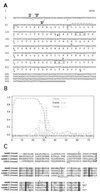Testatin: a cystatin-related gene expressed during early testis development
- PMID: 9826679
- PMCID: PMC24352
- DOI: 10.1073/pnas.95.24.14208
Testatin: a cystatin-related gene expressed during early testis development
Abstract
To isolate genes involved in morphogenic aspects of testis development, and which may act in cell signaling pathways downstream of the testis-determining gene Sry, we have developed a modified mRNA differential display method named signal peptide differential display. It was used to target those genes that encode proteins having a signal peptide sequence. By using this method, we isolated a gene named testatin. This gene was found to be related to a group of genes that encodes cysteine protease inhibitors known as cystatins. Cystatins and their target proteases have been associated with tumor formation and metastasis, but also are involved in natural tissue remodeling events such as bone resorption and embryo implantation. We show that testatin expression is restricted to fetal gonads and adult testis. Furthermore, testatin is expressed during testis cord formation in pre-Sertoli cells, believed to be the site of Sry action, at a time immediately after the peak of Sry expression. This finding suggests that testatin might be activated by transcription factors that are known to orchestrate the early testis development pathway. This gene therefore represents one of the putative downstream targets likely to have an essential role in tissue reorganization during early testis development.
Figures



References
-
- Nordqvist K, Lovell-Badge R. Nat Genet. 1994;7:7–9. - PubMed
-
- Gubbay J, Collignon J, Koopman P, Capel B, Economou A, Münsterberg A, Vivian N, Goodfellow P, Lovell-Badge R. Nature (London) 1990;346:245–250. - PubMed
-
- Sinclair A H, Berta P, Palmer M S, Hawkins J R, Griffiths B L, Smith M J, Foster J W, Frischauf A M, Lovell-Badge R, Goodfellow P N. Nature (London) 1990;346:240–244. - PubMed
-
- Koopman P, Gubbay J, Vivian N, Goodfellow P, Lovell-Badge R. Nature (London) 1991;351:117–121. - PubMed
-
- Capel B. Annu Rev Physiol. 1998;60:497–523. - PubMed
Publication types
MeSH terms
Substances
Associated data
- Actions
LinkOut - more resources
Full Text Sources
Other Literature Sources
Molecular Biology Databases

